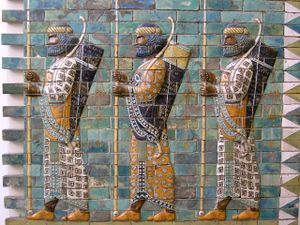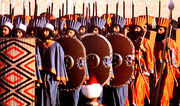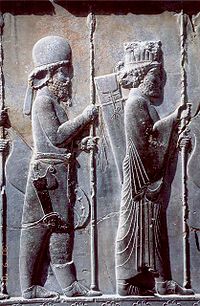Immortals (Persian Empire)

The "Immortals" (from the Greek Ἀθάνατοι, sometimes "Ten Thousand Immortals" or "Persian Immortals") was the name given by Herodotus to an elite force of soldiers who fought for the Achaemenid Empire. This force performed the dual roles of both Imperial Guard and standing army during the Persian Empire's expansion and during the Greco-Persian Wars. Its Persian name may have been Anûšiya ('companions').[1]
Herodotus describes the 'Immortals' as being heavy infantry led by Hydarnes that were kept constantly at a strength of exactly 10,000 men. He claimed that the unit's name stemmed from the custom that every killed, seriously wounded or sick member was immediately replaced with a new one, maintaining the cohesion of the unit.[2] The regiment accepted only Median, Elamite or Persian applicants.
This elite corps is only called the 'Immortals' in sources based on Herodotus. Whilst there is evidence for them from Persia, this does not mention this name for them.[1] "Probably, Herodotus' informant has confused the name Anûšiya ('companions') with Anauša ('Immortals')."[1]
Contents |
History
The 'Immortals' played an important role in Cyrus the Great's conquest of the Neo-Babylonian Empire in 547 BC, Cambyses' campaign against Egypt in 525 BC and Darius the Great's invasion of India and Scythia in 520 BC and 513 BC. Immortals participated in the Battle of Thermopylae 480 BC[3] and were amongst the Persian occupation troops in Greece in 479 BC under Mardonius.
Equipment

Herodotus describes their armament as follows: wicker shield, short spears, swords or large daggers, bow and arrow. Underneath their robes they wore scale mail coats, which, however, proved not as effective against the Greek weapons as the Greek linen or bronze cuirasses. The spear counterbalances of the common soldiery was silver; to differentiate commanding ranks, the officers' spear buttspikes were golden.[4] The regiment was followed by a caravan of covered carriages, camels, and mules that transported their supplies, along with concubines and attendants to serve them; this supply train carried special food that was reserved only for their consumption.[5]
The headdress worn by the Immortals is believed to have been the Persian tiara. Its actual form is uncertain but some sources describe it as a cloth or felt cap which could be pulled over the face to keep out wind and dust in the arid Persian plains.[4] Surviving Achaemenid coloured glazed bricks and carved reliefs represent the Immortals as wearing elaborate robes and gold jewelry[6].
Legacy
The title of "Immortals" was first revived under the Sassanid army. The most famous of the Savaran units were the Zhayedan (Immortals) and numbered 10,000 men, like the Achaemenid predecessors, with the difference that they were cavalry. Their task was mainly to secure any breakthroughs and to enter battles at crucial stages.

The title of "Immortals" was again revived under the Byzantine Empire, under the Emperor Michael VII (1071–1081). His general Nikephoros reorganised the central field army ("Tagmata") of the Eastern Empire following the disastrous defeat of Manzikert by the Turks in 1071. The remnants of the provincial troops of the Eastern Themes (military provinces) were brought together in a new Imperial Guard regiment named after the Persian Immortals and reportedly also numbering about 10,000 men.
Many centuries later during the Napoleonic Wars/Wars of the Coalitions, French soldiers referred to Napoleon's Imperial Guard as "the Immortals."[7]
The modern Iranian Army under the last Shah included an all volunteer Javidan Guard, also known as the "Immortals" after the ancient Persian royal guard. The "Immortals" were based in the Lavizan Barracks in Tehran. By 1978 this elite force comprised a brigade of 4,000–5,000 men, including a battalion of Chieftain tanks. Following the overthrow of the Imperial regime in 1979 the "Immortals" were disbanded.
In popular culture
- Frank Miller's comic book 300, turned into a motion picture in 2007, presents a heavily fictionalized version of the Immortals at the Battle of Thermopylae. These Immortals are lizard-like mutants, wear menpō-style metal masks, and carry a pair of swords closely resembling Japanese wakizashis.
- The 1962 film The 300 Spartans includes a far less fanciful depiction of the Immortals than the later film 300. They carry a spear and wicker shields, like the actual Immortals; however, they are mostly dressed in black and other dark colors.
- In the History Channel documentary Last Stand of the 300, the tiara the Immortals habitually wear is depicted here as a full-face black cloth mask transparent enough to see through.
- In the computer game Civilization III, Immortals are an infantry unit uniquely available to the Persian player. However, in its sequel, Civilization IV, they are depicted as a mounted unit.
- The Blue Mage job in Final Fantasy XI's Treasures Of Aht Urhgan expansion allude to the Immortals, with distinct turbans and veils among their eastern garb and directly serving the Empress.
- The Immortals were featured in the second season of Deadliest Warrior, as fighting against the Celts. They were also featured during the "Spartan" Segments in Season 1 and the "Alexander the Great" Segments in Season 2.
References
- ↑ 1.0 1.1 1.2 Lendering, Jona, Immortals, Greek name for an elite regiment in the ancient Achaemenid empire, Iran Chamber Society
- ↑ Jona Lendering. "The Persian Immortals". Ancient Persia. http://www.livius.org/ia-in/immortals/immortals.html. Retrieved 6 September 2009.
- ↑ Jona Lendering. "Thermopylae". Ancient Persia. http://www.livius.org/th/thermopylae/thermopylae2.html. Retrieved 6 September 2009..
- ↑ 4.0 4.1 [1]. Retrieved 16 May 2009.
- ↑ Cook, J.M. The Persian Empire. New York: Schocken Books, 1983. Page 105.
- ↑ Volume IX, Encyclopaedia Britannica, Fifteenth Edition 1983
- ↑ Georges Blond, La Grande Armée, trans. Marshall May (New York: Arms and Armor, 1997), 48, 103, 470